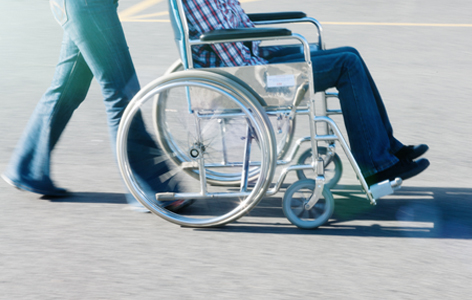Home page Description:
Designer peptides boost the effects of stem cell therapy for spinal cord injury.
Posted On: November 21, 2016

Image Caption:
Approximately 4,300 new cases of traumatic spinal cord injury occur in Canada every year, most commonly in males between the ages of 20 and 29.
Immediately after spinal cord injury, healthy nerve cells self-destruct, toxic factors are released at the site of injury, and scars or cavities form. This cascade of events can lead to partial or complete paralysis depending upon the severity and location of the injury.
Neural precursor cells (NPC)—which are stem cells that give rise to nerve cells—have shown great promise at repairing spinal cord injury; however, their use as a treatment is limited because the hostile conditions at the site of injury causes them to die.
Krembil Senior Scientist Dr. Michael Fehlings has been exploring ways to promote NPC survival by using artificially created peptide building blocks that can self-assemble into three-dimensional structures. These structures promote NPC survival by acting as a supportive scaffold that bridges the cavity that can be formed after injury. As a result of enhanced survival, NPCs are able to grow into healthy neurons that replace the damaged ones.
Dr. Fehlings and his team recently evaluated the potential of a novel self-assembling peptide (QL6) in further enhancing the effects of NPC therapy. His team found that injecting the peptide at sites of spinal cord injury not only increased transplanted NPC survival, but also led to improvements in limb function.
“We think that self-assembling QL6 peptides are an exciting strategy for promoting neural precursor survival,” explains Dr. Fehlings. “And we will be pursuing further research to evaluate their potential to support nerve cell regeneration and repair spinal cord injuries.”
This work was supported by the Canadian Institutes of Health Research, the Krembil Foundation, the German Research Society and the Toronto General & Western Hospital Foundation.
Self-assembling peptides optimize the post-traumatic milieu and synergistically enhance the effects of neural stem cell therapy after cervical spinal cord injury. Zweckberger K, Ahuja CS, Liu Y, Wang J, Fehlings MG. Acta Biomaterials. doi: 10.1016/j.actbio.2016.06.016. 2016 Sep 15. [Pubmed abstract]
Neural precursor cells (NPC)—which are stem cells that give rise to nerve cells—have shown great promise at repairing spinal cord injury; however, their use as a treatment is limited because the hostile conditions at the site of injury causes them to die.
Krembil Senior Scientist Dr. Michael Fehlings has been exploring ways to promote NPC survival by using artificially created peptide building blocks that can self-assemble into three-dimensional structures. These structures promote NPC survival by acting as a supportive scaffold that bridges the cavity that can be formed after injury. As a result of enhanced survival, NPCs are able to grow into healthy neurons that replace the damaged ones.
Dr. Fehlings and his team recently evaluated the potential of a novel self-assembling peptide (QL6) in further enhancing the effects of NPC therapy. His team found that injecting the peptide at sites of spinal cord injury not only increased transplanted NPC survival, but also led to improvements in limb function.
“We think that self-assembling QL6 peptides are an exciting strategy for promoting neural precursor survival,” explains Dr. Fehlings. “And we will be pursuing further research to evaluate their potential to support nerve cell regeneration and repair spinal cord injuries.”
This work was supported by the Canadian Institutes of Health Research, the Krembil Foundation, the German Research Society and the Toronto General & Western Hospital Foundation.
Self-assembling peptides optimize the post-traumatic milieu and synergistically enhance the effects of neural stem cell therapy after cervical spinal cord injury. Zweckberger K, Ahuja CS, Liu Y, Wang J, Fehlings MG. Acta Biomaterials. doi: 10.1016/j.actbio.2016.06.016. 2016 Sep 15. [Pubmed abstract]

